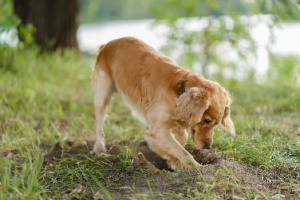
Why dogs bury treats is an instinctual behavior rooted in their ancestral past.
More...
Dogs bury treats to engage in scenting activities, enjoy long-lasting chewing sessions, and savor their snacks as rewards while playing.
Furthermore, dogs have long been known for their quirky behaviors, including burying treats or bones.
In fact, when wild dogs had to hide and store excess food for later consumption, their ancestral roots trace this peculiar behavior.
Despite being domesticated, dogs exhibit this instinctual behavior for various reasons.
This article will explore why dogs still engage in treat-burying habits today.
Dogs Bury Treats: Wild Instinct Persists
Dogs have an instinct to bury their treats or bones. This behavior is rooted in their ancestral history when wild dogs had to hide and store excess food for later consumption.
Although domesticated pets today lead lives filled with love and care provided by humans. They still possess innate instincts inherited from their wild ancestors.
Despite centuries of coexistence with humans, these instincts manifest in various ways. Burying treats is one example of such behavior.
Whether driven by preservation instincts, hoarding tendencies, the need for security, or sensory appeal, dogs continue displaying this fascinating behavior.
Moreover, it's essential for pet owners not only to understand their dog's behavior. They should also cater to them appropriately by providing alternative outlets, such as puzzle toys or designated digging areas within controlled environments.
Instinctual Preservation of Food
One of the primary reasons dogs bury their treats is their innate survival instincts inherited from their ancestors.
As descendants of wolves and other hunting canines, they have an ingrained drive to preserve food for times when resources are scarce.
Dogs view hiding treats as a defensive strategy against potential competitors who may try to steal or challenge them over valuable resources.
By burying their treats, dogs instinctively believe they are keeping them safe from others' prying eyes and sharp noses.
However, even though dogs now live comfortably with humans, they have retained many survival instincts from their ancestors.
Dogs Bury Treats to Hoard Resources
In addition to the preservation aspect, some experts believe that dogs might engage in treat-burying behavior due to hoarding tendencies.
Dogs bury treats to satisfy their natural desire to hoard resources and ensure a future source of nourishment.
Similarly, as some humans collect and save items, dogs may need to stash away their treasures for future use.
Further, it is a way of accumulating resources and feeling more secure.
Another explanation behind the treat-burying phenomenon is akin to the hoarding behavior observed in humans.
Like some people collect and save items for future use or sentimental value, certain dogs feel compelled to hoard their prized possessions. They hide treats in hidden spots.
It's important to note that this hoarding-like tendency varies among different dog breeds and individual personalities within those breeds.
Likewise, some pups may display more intense hoarding behaviors due to genetic predispositions influenced by selective breeding practices over generations.
Sense of Security
Apart from preservation and hoarding instincts, one key reason why dogs bury treats is because it gives them a sense of security.
Dogs bury treats for security, knowing they have something hidden that can be relied upon.
Thus, by concealing these edible treasures deep within the earth or beneath cushions/pillows, dogs believe they have created secret havens only they know.
Besides, this perceived sense of security stems from their instinct to protect valuables and preserve them for future use.
Therefore, knowing they have ample resources hidden away brings dogs peace of mind, especially during uncertain times or when transitioning between meals.
By hiding treats underground or in inconspicuous places around the house or yard, they create a personal storage space only known to them.
Interestingly, not all dogs display treat-burying behavior. Each dog has unique personality traits influenced by genetics and training environment, among other factors.
However, some may prefer devouring their treats immediately rather than going through the process of storing them away.
Satisfying Sensory Needs and Mental Stimulation
Dogs bury treats for mental stimulation and physical exercise.
Likewise, digging and burying engage multiple sensory channels in a dog's brain: smell, touch, taste, and proprioception. This engagement with various senses contributes to the appeal behind this behavior.
The sensory appeal satisfies various needs while providing mental stimulation for the dog.
Digging the earth with paws allows dogs to experience tactile sensations while unearthing fresh scents.
This sensory stimulation is also profoundly fulfilling for canines as it taps into their primal instincts.
Moreover, burying treats provides mental stimulation by challenging dogs' problem-solving abilities.
In the same way, it encourages an active thought process. They must strategize how deep to dig or which hiding spot would be most secure for a mini treasure hunt!
Furthermore, some experts suggest that burying treats could serve as a form of self-soothing or stress relief for dogs.
Similar to how humans engage in repetitive behaviors like nail biting or hair twirling when feeling anxious, dogs might find comfort in engaging with their treats through digging and hiding them.
Breed Differences and Other Factors
It is also worth mentioning that breed differences can play a role in whether or not a dog engages in treat-burying behavior.
Equally important, some breeds have stronger instincts due to their working background or genetic predisposition towards hoarding tendencies.
Researchers conducted studies exploring the topic to understand better the reasons behind treat-burying behavior among different types of dogs.
Moreover, they found that certain breeds, such as terriers and retrievers, are likelier to display this behavior than others.

In the Final Analysis
When dogs bury treats, they transform retrieving buried treasures into an exhilarating game of exploration and reward.
Also, we attribute dogs' innate tendency to bury treats to various factors rooted in their ancestral history and individual personalities.
Additionally, from preserving food sources through instinctual behaviors inherited from wild ancestors to satisfying sensory needs and offering mental stimulation, the reasons behind treat-burying habits are diverse yet interconnected.
Moreover, embracing our furry friends' natural inclinations without suppressing them can foster a healthier balance between domestication. Honoring their ancestral origins is also important in this process.
Remember, each dog has unique personality traits influenced by genetics, training, and environment, among other factors.
So, if your furry friend doesn't exhibit treat-burying habits, don't fret; it's just another example of the diverse nature of our beloved pets.



